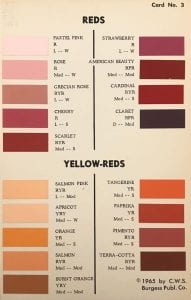Blog post by Grace A. Myers ’25
This online blog post features materials protected by the Fair Use guidelines of Section 107 of the US Copyright Act. All rights reserved to the copyright owners.
The traditional notion of growing up as a girl in America involved dressing up in heels two times the size of your feet and playing with your mother’s makeup, enjoying the idea of femininity in its purest state. However, the way in which that femininity presented itself in the media was different for white girls and black girls. White girls were given helpful examples of what to wear and how to complement their own bodies that their black counterparts lacked. And it wasn’t just a lack or representation, but a complete misrepresentation of black girls and women in America. Black women, especially those of a darker complexion, saw a masculinized version of themselves throughout the media that unfairly stripped them of their feminine attributes in the eyes of the general public, and in the eyes of themselves.
Author Charleszine Wood Spears hoped to address this issue when she wrote the book How to Wear Colors – With Emphasis on Dark Skins. Written in 1937 and published by the Minneapolis Burgess Publishing Company, How to Wear Colors is a guide about the best way to dress for your personal complexion, with tips on color, shape, style, and accentuation. The version discussed in this article is not the first edition, but the fourth, which was published in 1965. Having multiple editions that span across decades shows just how necessary it was for darker-skinned women to have representation when it came to ideas about dress and fashion. The book contains sixty-seven pages of writing bound together in rigid coverings, and its exposed cardboard hardback is accented with a maroon canvas, smoothly wrapped around the binding. Inside there are two pieces of colored card stock (one at the beginning and one at the end) acting as the cover pages. The front card stock is an illustration of four faces of varying skin tones, ranging from light tan to black; with stripes of yellow, blue, black, indigo, and green curved across an orange background displayed under it. The guide contains multiple diagrams explaining color theory, proportions, and other design elements (seen in Figures 1 and 2), and even offers a physical color guide of mounted color samples that is stored in a back cover pocket (Figures 3-6). In chapter three, Spears introduces four principles of design including proportion, emphasis, balance, and rhythm. For each, she explains the concept and translates their usage into how women can enhance their way of dress by using necklines, hair styles, and elements like radiation. Spears was one of only a few to provide this guidance to black and dark-skinned women, making the information she shared especially useful.

Figure 1: Radiation Diagram from: Spears, Charleszine Wood. How to Wear Colors – With Emphasis on Dark Skins. p. 42

Figure 2: Gradation Diagram from: Spears, Charleszine Wood. How to Wear Colors – With Emphasis on Dark Skins. p. 43

Figure 4: Color Guide Card No. 2 from: Spears, Charleszine Wood. How to Wear Colors – With Emphasis on Dark Skins.

Figure 3: Color Guide Card No. 1 from: Spears, Charleszine Wood. How to Wear Colors – With Emphasis on Dark Skins.
When discussing skin tones and their respective complementary colors, Spears uses words like “beautiful” and a “magnet” (Spears, 20), showcasing the subtle and purposeful femininity in her diction. Often in the media, black women are portrayed as aggressive and forced into harmful stereotypes that have been created by, and for, white audiences. While some assumptions include contradicting attitudes—for example, the Mammy archetype which showcases black women as “subservient” and “nurturing” and the Jezebel archetype which shows a contrasting demeanor of “promiscu[ity] and seducti[on]” (Taylor and Francis, 57)—Spears focuses on the unfounded beliefs that black women are hostile and unruly. In Caged Women: Incarceration, Representation, and Media, the idea of the Sapphire archetype is explained: “Taking its name after Ernestine Wade’s character Sapphire Stevens on the Amos ‘n’ Andy Show, [the Sapphire] represents Black women as ill-tempered and emasculating. [She] is often depicted as the angry or sassy Black woman” (Taylor and Francis, 57). During the Jim Crow era, African Americans were beaten and even killed for speaking out against white people, so characters like Sapphire Stevens were “allowed to pretend-chastise whites” indicating “that they were accepted as members of the white family” (Pilgrim, 2008). This was problematic because it affirmed the white belief that slavery, segregation, and racism were not as bad as black people made them out to be. By publishing a book centered around the femininity of dark-skinned women, Spears was able to acknowledge the inherent racism of segregation and current oppressions while also bringing to light the importance of inclusion when it comes to female-centered activities such as dress.

Figure 5: Color Guide Card No. 3 from: Spears, Charleszine Wood. How to Wear Colors – With Emphasis on Dark Skins.

Figure 6: Color Guide Card No. 4 from: Spears, Charleszine Wood. How to Wear Colors – With Emphasis on Dark Skins.
For centuries, the idea of what it means to be feminine was centered around white women, leaving little room for women of color, and more specifically black women. As Riche Richardson states in the book Emancipation’s Daughters: Reimagining Black Femininity and the National Body, “[the] conventional notions of national femininity that conflate whiteness and womanhood have been premised on the debasement and subjection of black women through race, class, gender, and sexuality” (26). Hyper-masculinized media portrayals stripped little black girls of their effeminate self-image and offered no representation in areas surrounding womanhood. That’s why Charleszine Wood Spears’ guide to color and wear was so influential. She offered dark-skinned girls and women processes and skills in areas like design and color theory in order to help them dress in ways that complemented their bodies and skin tones. Inclusivity in spaces, especially ones that are female-centered, are important because they not only dismantle harmful stereotypes, but boost the confidence of marginalized groups.
Grace is a freshman currently studying Fashion Design Management with the hopes of pursuing multiple minors in Business, Game Design, and Information Science. As of now, her career aspirations include becoming an Editor-in-Chief or Creative Director.
References
Hill Collins, P. (2000). Black feminist thought: knowledge, consciousness, and the politics of empowerment. (2nd ed., Rev. tenth anniversary ed.). New York: Routledge.
Pilgrim, D. D. (2008, August). The sapphire caricature. The Sapphire Caricature – Anti-black Imagery – Jim Crow Museum – Ferris State University. Retrieved December 4, 2021, from https://www.ferris.edu/HTMLS/news/jimcrow/antiblack/sapphire.htm.
Richardson, R. (2021). Emancipation’s daughters: reimagining black femininity and the national body. Retrieved from https://resolver.ebscohost.com/Redirect/PRL?EPPackageLocationID=3915047.27554321.73438091&epcustomerid=s9001366
Spears, C. W. (1965). How to wear colors: with emphasis on dark skins. (4th ed.). Minneapolis: Burgesss Pub. Co.
Taylor and Francis. (2018). Caged women: incarceration, representation, and media. (L. L. Gordy & S. A. Jackson, Eds.) (First edition.). Boca Raton, FL: Routledge, an imprint of Taylor and Francis. Retrieved from https://www.taylorfrancis.com/books/9781315099309

